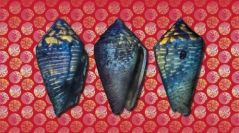

 Geodiversitas
46 (11) - Pages 423-444
Geodiversitas
46 (11) - Pages 423-444Fossil Conidae from Greece were recently studied in Late Miocene deposits and revealed a very diverse tropical fauna of 33 species, but this diversity decreased during the Pliocene (around six species). From the Pleistocene, four species were previously recorded in the island of Rhodes Conus (Lautoconus) ventricosus Gmelin, 1791 (synonym of Conus (Lautoconus) mediterraneus Hwass in Bruguière, 1792), Chelyconus pelagicus (sensu Chirli & Forli, 2011, non Brocchi, 1814), Chelyconus striatulus (sensu Chirli & Forli, 2011, non Brocchi, 1814) and Lithoconus mercati (sensu Chirli & Forli, 2011, non Brocchi, 1814). To update our knowledge on the conids from Rhodes, we studied material from the Tsampika section (265 ka - 140 ka corresponding from MIS 8 to MIS 6). We used ultraviolet light to observe intraspecific variations in the residual colour patterns. Three species are identified: Conus (Lautoconus) ventricosus rhodesensis n. subsp., Conus (Lautoconus) sp. and Conus (Monteiroconus) tsampikaensis n. sp. [previously assigned to C. (M.) mercati Brocchi, 1814]. Based on information about the habitat of the extant Conus (Monteiroconus) species, living today in West Africa and Caribbean in sea surface temperatures above 18 °C, we can hypothesise that the age of the specimens is within the interglacial period of MIS 7e to MIS 7c (241.8-212.9 (±0.4) ka). The different conid assemblages between the interglacial periods MIS 7 (Conus (Lautoconus) ventricosus rhodesensis n. subsp., Conus (Lautoconus) sp., and Conus (Monteiroconus) tsampikaensis n. sp.) and MIS 5 (“Conus (Lautoconus) ventricosus” Gmelin, 1791, Conus (Chelyconus) ermineus Born, 1778 and Conus (Monteiroconus) tabidus Reeve, 1844) in the Mediterranean suggest a colonisation of different species during specific interglacial periods, and the subsequent disappearance of most of those during the glacial periods.
Pleistocene, Greece, Rhodes, Conidae, Conus, palaeoecology, climate change, MIS 7, new subspecies, new species